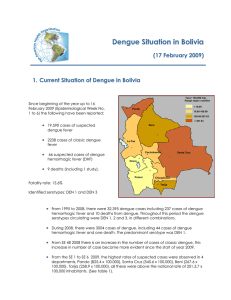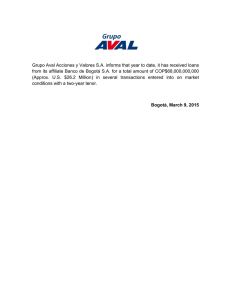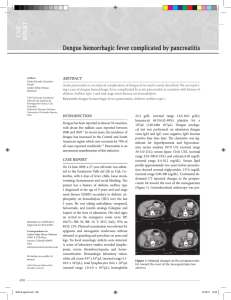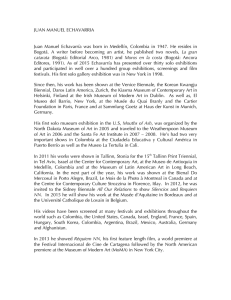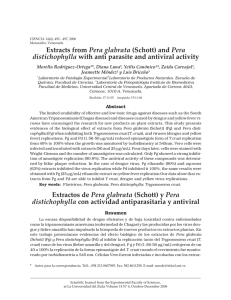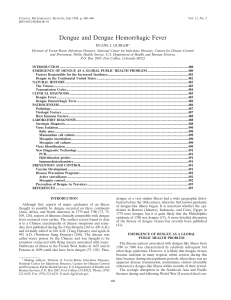Internal travel and risk of dengue transmission in Colombia
Anuncio
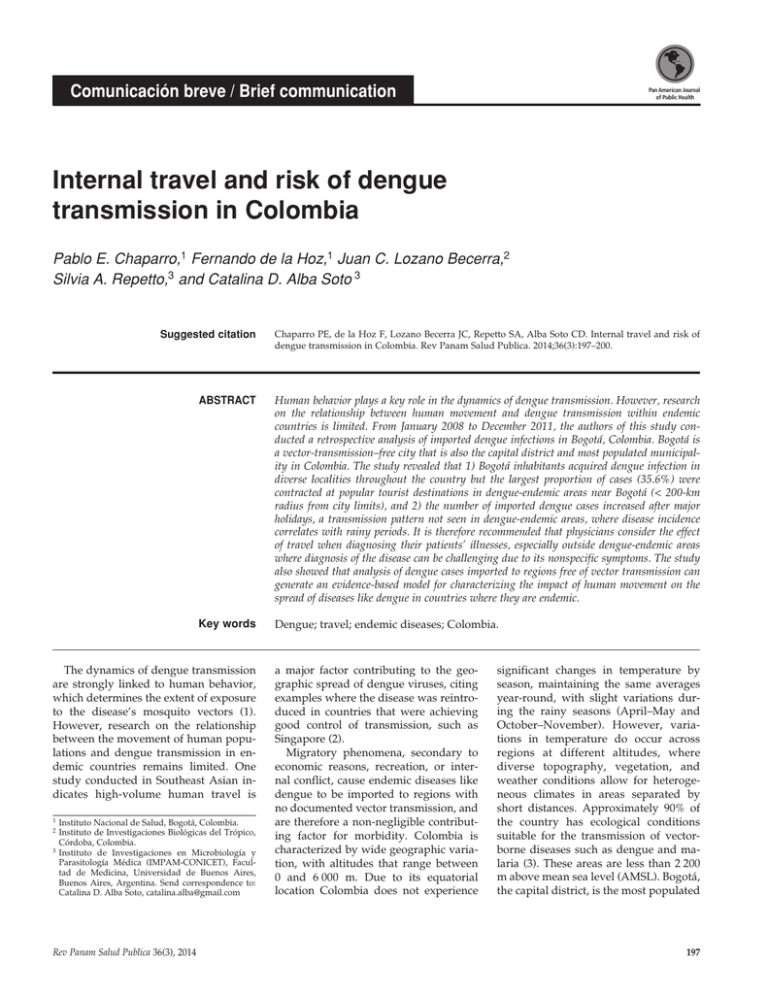
Comunicación breve / Brief communication Pan American Journal of Public Health Internal travel and risk of dengue transmission in Colombia Pablo E. Chaparro,1 Fernando de la Hoz,1 Juan C. Lozano Becerra,2 Silvia A. Repetto,3 and Catalina D. Alba Soto 3 Suggested citation Chaparro PE, de la Hoz F, Lozano Becerra JC, Repetto SA, Alba Soto CD. Internal travel and risk of dengue transmission in Colombia. Rev Panam Salud Publica. 2014;36(3):197–200. abstract Human behavior plays a key role in the dynamics of dengue transmission. However, research on the relationship between human movement and dengue transmission within endemic countries is limited. From January 2008 to December 2011, the authors of this study conducted a retrospective analysis of imported dengue infections in Bogotá, Colombia. Bogotá is a vector-transmission–free city that is also the capital district and most populated municipality in Colombia. The study revealed that 1) Bogotá inhabitants acquired dengue infection in diverse localities throughout the country but the largest proportion of cases (35.6%) were contracted at popular tourist destinations in dengue-endemic areas near Bogotá (< 200-km radius from city limits), and 2) the number of imported dengue cases increased after major holidays, a transmission pattern not seen in dengue-endemic areas, where disease incidence correlates with rainy periods. It is therefore recommended that physicians consider the effect of travel when diagnosing their patients’ illnesses, especially outside dengue-endemic areas where diagnosis of the disease can be challenging due to its nonspecific symptoms. The study also showed that analysis of dengue cases imported to regions free of vector transmission can generate an evidence-based model for characterizing the impact of human movement on the spread of diseases like dengue in countries where they are endemic. Key words Dengue; travel; endemic diseases; Colombia. The dynamics of dengue transmission are strongly linked to human behavior, which determines the extent of exposure to the disease’s mosquito vectors (1). However, research on the relationship between the movement of human populations and dengue transmission in endemic countries remains limited. One study conducted in Southeast Asian indicates high-volume human travel is 1 Instituto Nacional de Salud, Bogotá, Colombia. de Investigaciones Biológicas del Trópico, Córdoba, Colombia. 3Instituto de Investigaciones en Microbiología y Parasitología Médica (IMPAM-CONICET), Facultad de Medicina, Universidad de Buenos Aires, Buenos Aires, Argentina. Send correspondence to: Catalina D. Alba Soto, [email protected] 2Instituto Rev Panam Salud Publica 36(3), 2014 a major factor contributing to the geographic spread of dengue viruses, citing examples where the disease was reintroduced in countries that were achieving good control of transmission, such as Singapore (2). Migratory phenomena, secondary to economic reasons, recreation, or internal conflict, cause endemic diseases like dengue to be imported to regions with no documented vector transmission, and are therefore a non-negligible contributing factor for morbidity. Colombia is characterized by wide geographic variation, with altitudes that range between 0 and 6 000 m. Due to its equatorial location Colombia does not experience significant changes in temperature by season, maintaining the same averages year-round, with slight variations during the rainy seasons (April–May and October–November). However, variations in temperature do occur across regions at different altitudes, where diverse topography, vegetation, and weather conditions allow for heterogeneous climates in areas separated by short distances. Approximately 90% of the country has ecological conditions suitable for the transmission of vectorborne diseases such as dengue and malaria (3). These areas are less than 2 200 m above mean sea level (AMSL). Bogotá, the capital district, is the most populated 197 Brief communication 198 FIGURE 1. Box plots (top) of dengue cases contracted by Bogotá residents in 10 travel destinationsa outside city limits, and map (bottom) showing their location, altitude,b and connecting roads; Bogotá city limits (dark grey); regions free of vector-transmitted dengue (light grey); and regions at risk of vector-transmitted dengue (white), Colombia, January 2008–December 2011 150 125 No. of imported cases city, with about 7.5 million inhabitants, and a leading destination for internal migration (4). Situated at 2 600 m AMSL and with an average temperature ranging from 6–17°C, the city does not have the conditions for vector proliferation (or establishment). The authors of this study conducted a retrospective analysis of imported dengue infections in Bogotá, with a focus on the effect of travel to endemic areas, and the season, on disease incidence. Epidemiological notification forms for dengue cases clinically diagnosed in Bogotá health facilities from January 2008 to December 2011 were reviewed. Variables related to the probable place of infection; date of diagnosis; clinical classification, according to World Health Organization (WHO) criteria; scheme; and mortality (5) were recorded. The data obtained were compared with the annual statistics of the Colombian surveillance system (Sistema Nacional de Vigilancia en Salud Públic, SIVIGILA), which collects information on weekly incidence of suspected dengue cases (6). A total of 4 177 cases were clinically diagnosed and reported as suspicious for infection by the dengue virus. More than half the cases (2 194; 52.53%) were registered in 2010, a year of national-level outbreak. During that year 157 152 suspected cases were reported at the national level, five times the annual average. The majority of cases registered in Bogotá (3 553 or 85.1%) were classified, according to WHO criteria, as “dengue without warning signs.” Of the remaining cases, 624 (14.9%) were classified as “dengue with warning signs,” and of those, 12 patients were described as “severe dengue.” Two deaths attributed to dengue were reported during the epidemic of 2010. People diagnosed with dengue in Bogotá contracted the infection in 321 localities across different parts of the country, including the Caribbean and Pacific regions and the Amazon basin. However, 10 localities within 200 km of Bogotá city limits (a maximum distance of three hours by car) were the source of infection for the largest proportion of cases reported during the study period (35.6%) (Figure 1). The 10 localities, which include two department capitals (Ibagué and Villavicencio) and eight other municipalities (Anapoima, Carmen de Apicalá, Flandes, Girardot, La Mesa, Melgar, Tocaima, and Villeta), Chaparro et al. • Internal travel and risk of dengue transmission in Colombia 100 75 50 25 0 ot rd ira G r ga el M io nc V e vic illa A a m oi p na ué ag Ib a La es M Travel destination ta lá ica lle Vi e d C. Ap a m ai c To es nd a Fl a Box plots show cumulative values for 1st quartile (bottom), 2nd quartile (center band), and 3rd quartile (top); horizontal dashed line represents cumulative median. above mean sea level (AMSL). b Meters are popular tourist destinations of regional significance owing to their yearround warm-to-hot climate. In Girardot and Melgar, dengue is a prevalent disease causing significant morbidity (3). A total of 2 203 reported cases of all cases of imported dengue (51.95%) occurred in the months of January, April, and July, with January alone contributing 27.8%, based on a number of cases significantly higher than average (p < 0.05) (Figure 2). In Colombian endemic regions, the dengue transmission pattern is constant throughout the year, with only slight intensifications following rainy seasons (April–May and October–November) (7, 8). In contrast, in Bogotá, certain months have an increased incidence of imported dengue cases that appears to be closely correlated with holiday periods rather Rev Panam Salud Publica 36(3), 2014 Chaparro et al. • Internal travel and risk of dengue transmission in Colombia Brief communication FIGURE 2. Monthly distribution of dengue cases contracted by Bogotá residents, Colombia, January 2008–December 2011a,b 700 600 No. of imported cases 500 400 300 200 100 c De No v ct O p Se Au g Ju l Ju n r ay M Ap ar M Fe b Ja n 0 Monthly distribution a Horizontal b Significant dashed line represents median for cumulative (four-year) study period. difference (p < 0.05) found for January (Student’s t-test) versus other months. than rainy seasons. From late December to mid-January (the Christmas holiday); during Semana Santa (Holy Week, in March or April); and from mid-June to mid-July (mid-term break), tens of thousands of Bogotá inhabitants move to a broad range of localities that include dengue-endemic areas (9). Data reported to the GeoSentinel Surveillance Network on ill returned travelers from other regions of the world show that the pattern of imported dengue cases varies between “typical” (non-epidemic) and the increased incidence experienced during outbreak years (10). In the current analysis, the pattern of imported dengue transmission remained the same (correlated with holiday periods) throughout the four-year study period, which included a year of national outbreak (2010). As Bogotá is free of vector transmission, the main concern with regard to imported dengue cases is accurate diagnosis and treatment rather than prevention of secondary cases. However, the current study’s evidence on the relationship between population displacement linked to domestic tourism and the circulation of dengue virus suggests efforts to prevent primary transmission should also be a priority. Previously published literature on travel and dengue is pri- Rev Panam Salud Publica 36(3), 2014 marily focused on international travel between 1) the United States and Europe and 2) Latin America and Asia. The relationship between dengue and domestic tourism in the countries of South America has not been addressed. This study aims to fill that gap by highlighting the risk of dengue transmission to people residing in non-endemic regions who travel to dengue-endemic regions within the country for recreation or tourism. The fact that dengue symptoms are nonspecific (and similar to clinical presentations of other infectious diseases) makes dengue diagnosis challenging for physicians, especially in non-endemic regions. In addition, fever patients returning from travel to domestic dengue-endemic areas in developing countries do not always have access to the travel medical services international travelers receive during an illness. As shown in a study by Enk et al. that examined rural tourism as a risk factor for the transmission of schistosomiasis in Brazil (11), the lack of knowledge about clinical characteristics of endemic infectious diseases in non-endemic areas, even in tropical countries, delays their diagnosis and treatment. These knowledge gaps are most likely attributable to the lack of sub-registries for certain diseases, preventing the determination of their significance in terms of morbidity and even mortality in non-endemic cities like Bogotá. This problem is most likely not unique to Colombia, among the countries of South America, where more than 15 million people live in cities > 2 000 m AMSL, (e.g., Quito, La Paz, Bogotá, and Cuzco) that are nonendemic for diseases like dengue but are surrounded by lower-lying areas that are endemic. Standard measures to prevent insect bites among travelers from these higher-latitude non-endemic areas are indicated and should be actively promoted during vacation periods when population displacement to endemic areas is more frequent. The study of population movement is relevant to understanding the spread of disease. Importation of dengue cases from high-transmission areas to nonendemic areas is a contributing factor to the persistence or reemergence of the disease in non-endemic regions. For example, 5%–10 % of the dengue cases diagnosed in Singapore are imported from Indonesia, Malaysia, or Thailand, where control measures are less effective, hampering local efforts against the disease (12). The relative importance of human movement on vector-borne disease transmission dynamics is difficult to estimate independent of the vector behavior. In the current study, the assessment of imported dengue cases in a vector-free locality helped generate an evidence-based model of the effect of recreational human displacement on incidence of dengue. Understanding the role of human movement on dengue transmission will help inform travelers of the risks of becoming infected and enable public health authorities to improve dengue control policies and diagnosis and thus prevent complications of the disease. Acknowledgments. The authors thank Efrén A. Alba Soto for help with artwork, Juan Carlos Garzón for assistance with the language, and Natalia Norden for fruitful discussion of the ideas in the manuscript. CDAS is a member of the research staff of the National Scientific and Technical Research Council (Consejo Nacional de Investigaciones Científicas y Técnicas, CONICET) in Buenos Aires, Argentina. Conflicts of interest. None. 199 Brief communication Chaparro et al. • Internal travel and risk of dengue transmission in Colombia REFERENCES 1.Stoddard ST, Morrison AC, Vazquez-­ Prokopec GM, Paz Soldan V, Kochel TJ, et al. The role of human movement in the transmission of vector-borne pathogens. PLoS Negl Trop Dis. 2009;3(7):e481. doi: 10.1371/jour nal.pntd.0000481. 2. Ooi EE, Gubler DJ. Dengue in Southeast Asia: epidemiological characteristics and strategic challenges in disease prevention. Cad Saude Publica. 2009;25 Suppl 1:S115–24. 3. Quintero J, Carrasquilla G, Suárez R, González C, Olano VA. An ecosystemic approach to evaluating ecological, socioeconomic and group dynamics affecting the prevalence of Aedes aegypti in two Colombian towns. Cad Saude Publica. 2009;25 Suppl 1:S93–103. 4. Departamento Administrativo Nacional de Estadística (CO). Boletín: Censo general 2005. Perfil: Bogotá. Bogotá: DANE; 2005. Available from: http://www.dane.gov.co/files/censo2005/ PERFIL_PDF_CG2005/11001T7T000.PDF Accessed on 5 January 2013. resumen Desplazamientos internos y riesgo de transmisión del dengue en Colombia Palabras clave 200 5.World Health Organization. Dengue: guidelines for diagnosis, treatment, prevention and control. Geneva: WHO; 2009. 6.Instituto Nacional de Salud (CO). Protocolo para la vigilancia en salud pública del dengue. Bogotá: INS; 2012. Available from: http://www.ins.gov.co/temas-de-interes/ Dengue/01%20Protocolo%20Dengue.pdf Accessed on 20 April 2013. 7.García Giraldo JA, Boshell JF. Modelos de simulación y predicción del comportamiento del dengue en cuatro ciudades de Colombia, incluyendo el clima como variable moduladora de la enfermedad. Meteorol Colomb. 2004;8:53–9. 8. Padilla JC, Rojas DP, Sáenz-Gómez R. Dengue en Colombia: epidemiología de la reemergencia a la hiperendemia. Bogotá: Universidad del Rosario; 2012. Pp. 27–8. 9. Gómez Tobón JA. Turismo, conflicto armado y paz en Colombia: apostándole al futuro. Anuario Turismo y Sociedad. 2002;1(1):4–56. 10.Schwartz E, Weld LH, Wilder-Smith A, von Sonnenburg F, Keystone JS, Kain KC, et al. Seasonality, annual trends, and characteristics of dengue among ill returned travelers, 1997– 2006. Emerg Infect Dis. 2008;14(7):1081–8. doi: 10.3201/eid1407.071412. 11.Enk MJ, Amaral GL, Costa e Silva MF, Silveira-Lemos D, Teixeira-Carvalho A, ­ Martins-Filho OA, et al. Rural tourism: a ­ risk factor for schistosomiasis transmission in Brazil. Mem Inst Oswaldo Cruz. 2010;105(4):537–40. 12. Ooi EE, Goh KT, Gubler DJ. Dengue prevention and 35 years of vector control in Singapore. Emerg Infect Dis. 2006;12(6):887–93. Manuscript received on 21 April 2014. Revised version accepted for publication on 2 September 2014. El comportamiento humano es un factor clave en la dinámica de transmisión del dengue. Sin embargo, la investigación sobre la relación entre los desplazamientos de personas y la transmisión del dengue en los países con endemicidad es escasa. Los autores realizaron un análisis retrospectivo de las infecciones por dengue importadas a Bogotá, Colombia, de enero del 2008 a diciembre del 2011. Bogotá es una ciudad libre de transmisión por vectores que además es la capital y también el municipio más poblado de Colombia. El estudio reveló que: 1) los habitantes de Bogotá contraían la infección por dengue en diferentes localidades del país, pero la mayor proporción de casos (35,6%) se había registrado en destinos turísticos populares de zonas endémicas cercanas a Bogotá (en un radio de < 200 km respecto de los límites de la ciudad), y 2) el número de casos importados de dengue aumentaba después de los feriados más importantes, un patrón de transmisión que no se observaba en las zonas endémicas, en las que la incidencia de la enfermedad se correlacionaba con las épocas de lluvias. Por consiguiente, los autores recomiendan que los médicos tomen en cuenta el factor del viaje a la hora de diagnosticar a sus pacientes, especialmente fuera de las áreas endémicas, en las que el diagnóstico del dengue puede ser problemático debido a la inespecificidad de los síntomas. El estudio también indicó que el análisis de los casos de dengue importados a las regiones libres de transmisión por vectores puede ser útil para generar un modelo basado en datos probatorios que permita determinar la repercusión de los desplazamientos de personas en la propagación enfermedades como el dengue, en los países donde son endémicas. Dengue; viaje; enfermedades endémicas; Colombia. Rev Panam Salud Publica 36(3), 2014
